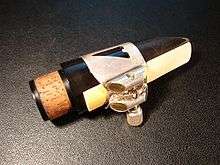Single-reed instrument

A single-reed instrument is a woodwind instrument that uses only one reed to produce sound. The very earliest single-reed instruments were documented in ancient Egypt, as well as the Middle East, Greece, and the Roman Empire.[1] The earliest types of single-reed instruments used idioglottal reeds, where the vibrating reed is a tongue cut and shaped on the tube of cane. Much later, single-reed instruments started using heteroglottal reeds, where a reed is cut and separated from the tube of cane and attached to a mouthpiece of some sort. By contrast, in a double reed instrument (such as the oboe and bassoon), there is no mouthpiece; the two parts of the reed vibrate against one another. Reeds are traditionally made of cane and produce sound when air is blown across or through them.
Most single-reed instruments are descended from single-reed idioglot instruments called 'memet', found in Egypt as early as 2700 BCE.[2] Due to their fragility, no instruments from antiquity were preserved but iconographic evidence is prevalent. During the Old Kingdom in Egypt (2778–2723 BCE), memets were depicted on the reliefs of seven tombs at Saqqarra, six tombs at Giza, and the pyramids of Queen Khentkaus.[3] Most memets were double-clarinets, where two reed tubes were tied or glued together to form one instrument. Multiple pipes were used to reinforce sound or generate a strong beat-tone with slight variations in tuning among the pipes.[4] One of the tubes usually functioned as a drone, but the design of these simple instruments varied endlessly.[5] The entire reed entered the mouth, meaning that the player could not easily articulate so melodies were defined by quick movement of the fingers on the tone holes.[1] These types of double-clarinets are still prevalent today, but also developed into simplified single-clarinets and hornpipes. Modern-day idioglots found in Egypt include the arghul and the zummara.[1]
Examples include clarinets, saxophones, and some bagpipes. See links to other examples below.
Classification
Single reed instruments fall under three Hornbostel–Sachs classes:
- 412.13 Free reeds.
- 422.2 Single reed instruments: The pipe has a single 'reed' consisting of a percussion lamella. These are the percussion reeds including clarinets and saxophones.
- 422.3 Reedpipes with free reeds: The reed vibrates through [at] a closely fitted frame, and there are fingerholes.
Comparing clarinets and saxophones
The following is a list of clarinets and saxophones, relative to their range and key of transposition from the opposite family:
| Range | Clarinet | Saxophone |
|---|---|---|
| B♭ Soprano | Soprano | Soprano |
| E♭ Alto | Alto | Alto |
| B♭ Tenor | Bass | Tenor |
| E♭ Baritone | Contra-alto | Baritone |
| B♭ Bass | Contrabass | Bass |
Note that if one was to compare clarinets to their saxophone counterparts while considering their approximate lowest (concert) pitch†, the order would shift:
| Lowest Pitch | Clarinet | Saxophone |
|---|---|---|
| ~A♭3 | E♭ Soprano | B♭ Soprano |
| ~D♭3 | B♭ Soprano | E♭ Alto |
| ~A♭2 | E♭ Alto | B♭ Tenor |
| ~B♭1 | B♭ Bass | E♭ Baritone |
| ~A♭1 | E♭ Contra-alto | B♭ Bass |
| ~B♭0 | B♭ Contrabass | E♭ Contrabass |
- †The lowest possible pitch of each clarinet and saxophone is dependent on its manufacturer and model (the pitches used are typical of professional instruments).
List of single-reed instruments

Modern
Historical
Traditional
- European
- Middle Eastern
References
- 1 2 3 Hoeprich, E (2008). The Clarinet. New Haven, CT: Yale University Press.
- ↑ Midgley, R, ed. (1976). Musical Instruments of the World. United States: Diagram Visual Information Ltd.
- ↑ Rice, A.R. (1992). The Baroque Clarinet. New York, NY: Oxford University Press.
- ↑ Rendall, G.F. (1971). The Clarinet: Some notes upon its history and construction. New York, NY: W.W. Norton and Company.
- ↑ Kroll, O (1968). The Clarinet. New York, NY: Taplinger Publishing Company.